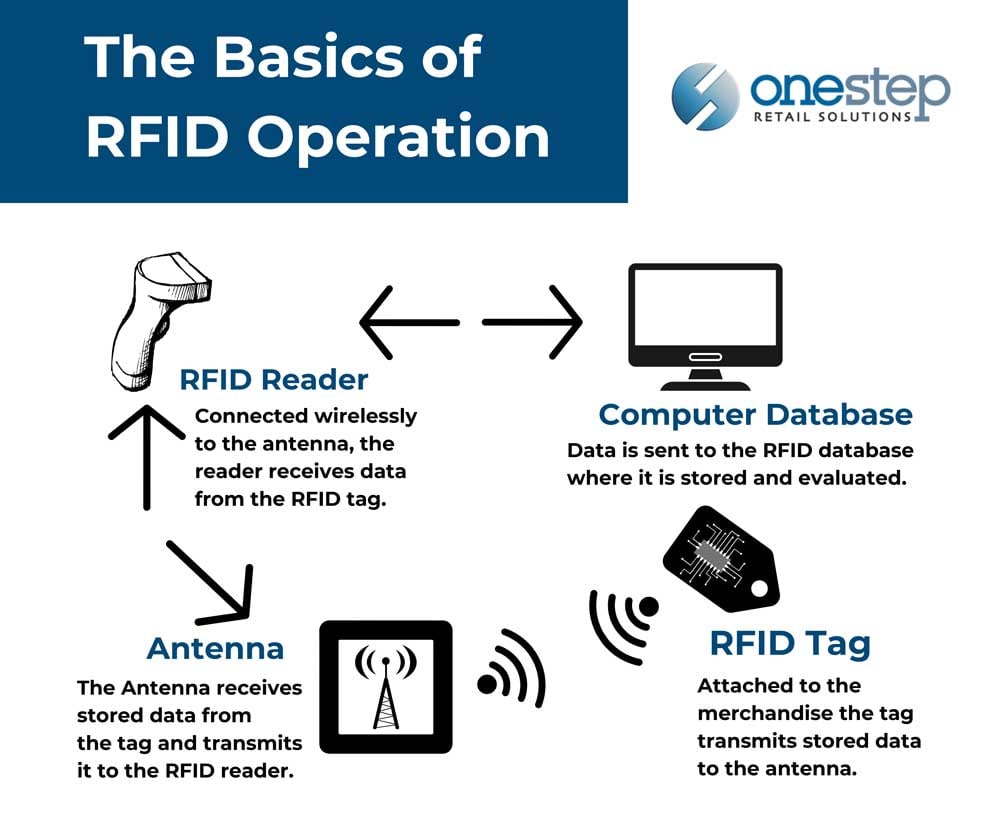Gone are the days when RFID technology was solely reserved for the retail giants. Today, it's more accessible than ever, even for small businesses. With advancements in technology and decreasing costs, Radio Frequency Identification (RFID) has become a viable option for stores of all sizes.
RFID technology is a game-changer for retailers aiming to enhance their operations. Consisting of two key components—tags and readers—RFID operates wirelessly. At its core, a reader is equipped with one or more antennas, facilitating the transmission and reception of electromagnetic signals to and from RFID tags.
Despite its technical nature, RFID implementation is more manageable than it may initially seem. With the right guidance and support, retailers can navigate the process smoothly, finding that RFID adoption is more accessible than they might have anticipated.
According to GS1 US, with RFID, retailers see inventory accuracy rise from 63% to 95%. RFID improves labor productivity by 96%, reduces cycle count time by 96%, and cuts out-of-stocks by as much as 50%.
How can RFID help your retail business?
Inventory Management: RFID enables real-time inventory tracking, allowing retailers to maintain accurate stock levels and reduce instances of stockouts or overstocking. With RFID, retailers can automate inventory counts, streamline replenishment processes, and enhance overall inventory accuracy.
Increased Efficiency: RFID streamlines various operational processes within retail environments. It simplifies tasks such as receiving goods, stock replenishment, and checkout processes by quickly and accurately identifying items. This efficiency leads to better productivity and helps boost sales. It also guides retailers away from environmentally harmful practices of overstocking.
Enhanced Visibility: RFID provides retailers with improved visibility into their supply chain and store operations. They can track the movement of goods from the warehouse to the store floor, monitor inventory levels in real time, and identify areas for optimization or improvement.
Loss Prevention: RFID technology aids in reducing losses due to theft, misplacement, or shrinkage. By accurately tracking inventory movements and implementing anti-theft measures, retailers can mitigate the risk of inventory losses and unauthorized removal of items from the store.
Improved Customer Experience: RFID enables retailers to offer enhanced customer experiences through initiatives such as faster checkout processes, improved product availability, and personalized services. With RFID, retailers can ensure that the right products are available when and where customers need them, leading to increased customer satisfaction and loyalty.
Data Insights: RFID generates valuable data insights that retailers can leverage to make informed business decisions. By analyzing data collected from RFID tags and readers, retailers can gain insights into consumer behavior, optimize product assortments, and identify trends to better meet customer demands.
Overall, RFID technology empowers retailers to operate more efficiently, improve inventory management, reduce costs, and enhance the overall shopping experience for customers.

What Does the RFID Setup Process Look Like?
Many Point-of-Sale (POS) system companies recognize the value of integrating RFID technology into their software and programs. Traditionally focused on processing transactions and managing inventory, POS systems are now embracing RFID to enhance their capabilities and provide even greater value to retailers.
Integrating RFID technology into a retail environment can be transformative, but it doesn't have to be daunting. Partnering with an outside retail tech company can make the transition smoother and more efficient.
Companies like One Step Retail Solutions specialize in guiding businesses through the process, offering expertise, resources, and support every step of the way. From initial planning to implementation and beyond, they provide tailored solutions to meet the unique needs of each retailer.
With their assistance, businesses can navigate the complexities of RFID adoption with confidence, ensuring a seamless transition and unlocking the full potential of this groundbreaking technology.
Setting up RFID in a retail store involves a few steps:
Tagging Products: The first step is tagging products. RFID tags, which are small electronic chips, are attached to each item in the store. These tags contain unique information about the product, such as its identification number and other details.
Installing Readers: Next, RFID readers are strategically placed throughout the store. These readers are devices equipped with antennas that send out radio waves and receive signals from the RFID tags on the products. They're usually installed at key points like entrances, exits, and storage areas.
Connecting to Software: The RFID readers are connected to software systems that manage and process the data collected from the tags. This software helps track the movement of products in real time, manage inventory levels, and generate reports.
Calibration and Testing: Once everything is set up, the system needs to be calibrated and tested to ensure accuracy and reliability. This involves fine-tuning the readers and software settings to optimize performance and eliminate any potential issues.Training Staff: Staff members need to be trained on how to use the RFID system effectively. They should understand how to read the data collected by the readers, interpret inventory reports, and troubleshoot any issues that may arise.
Integration with Existing Systems: In many cases, the RFID system needs to be integrated with other existing systems in the store, such as point-of-sale (POS) systems and inventory management software. This ensures seamless operation and data synchronization across all systems.
Once everything is in place, the store can enjoy the benefits of improved inventory management, increased efficiency, and enhanced customer experiences.
Embracing the RFID Evolution in Retail
As an increasing number of retailers embrace RFID integration, it's evident that it's not just about tracking products; it's about enhancing the way they operate and cater to their customers.
With the guidance of experienced retail tech partners, retailers can navigate the transition smoothly, ensuring a seamless adoption of RFID technology.
From improving inventory accuracy to enhancing the customer experience, the benefits are tangible and promising. With each step forward, retailers are shaping the future of industry technology.

